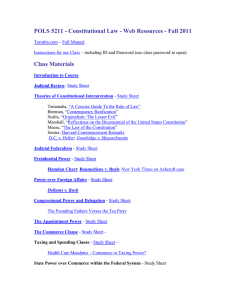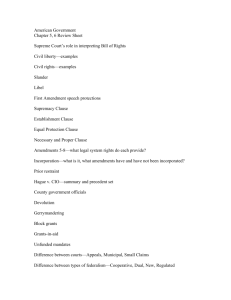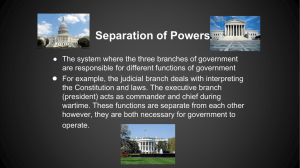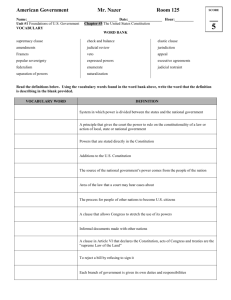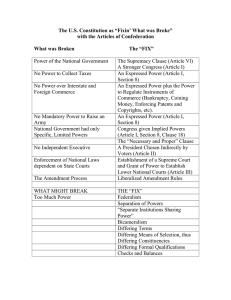IV. The Bill of Rights
advertisement
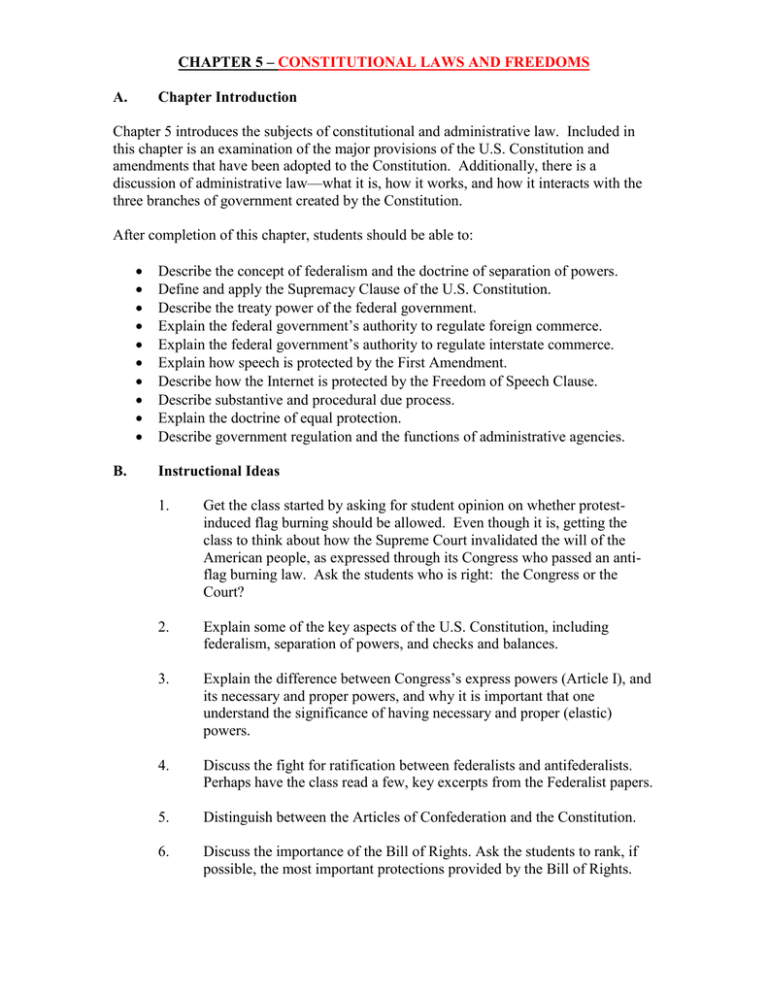
CHAPTER 5 – CONSTITUTIONAL LAWS AND FREEDOMS A. Chapter Introduction Chapter 5 introduces the subjects of constitutional and administrative law. Included in this chapter is an examination of the major provisions of the U.S. Constitution and amendments that have been adopted to the Constitution. Additionally, there is a discussion of administrative law—what it is, how it works, and how it interacts with the three branches of government created by the Constitution. After completion of this chapter, students should be able to: B. Describe the concept of federalism and the doctrine of separation of powers. Define and apply the Supremacy Clause of the U.S. Constitution. Describe the treaty power of the federal government. Explain the federal government’s authority to regulate foreign commerce. Explain the federal government’s authority to regulate interstate commerce. Explain how speech is protected by the First Amendment. Describe how the Internet is protected by the Freedom of Speech Clause. Describe substantive and procedural due process. Explain the doctrine of equal protection. Describe government regulation and the functions of administrative agencies. Instructional Ideas 1. Get the class started by asking for student opinion on whether protestinduced flag burning should be allowed. Even though it is, getting the class to think about how the Supreme Court invalidated the will of the American people, as expressed through its Congress who passed an antiflag burning law. Ask the students who is right: the Congress or the Court? 2. Explain some of the key aspects of the U.S. Constitution, including federalism, separation of powers, and checks and balances. 3. Explain the difference between Congress’s express powers (Article I), and its necessary and proper powers, and why it is important that one understand the significance of having necessary and proper (elastic) powers. 4. Discuss the fight for ratification between federalists and antifederalists. Perhaps have the class read a few, key excerpts from the Federalist papers. 5. Distinguish between the Articles of Confederation and the Constitution. 6. Discuss the importance of the Bill of Rights. Ask the students to rank, if possible, the most important protections provided by the Bill of Rights. C. 7. Explain how the Supreme Court has interpreted the First Amendment’s free speech clause. Ask for examples of speech that would be fully protected, partially protected, and unprotected. Give an example of religious or political speech that could still be restricted or prohibited, even though such speech is generally considered fully protected speech. 8. Explain how the due process protection has been interpreted to have two parts: substantive and procedural due process. Have the class break into groups and create statutes that would violate the vagueness doctrine. Then have each incorrectly drafted statute cleaned up by another group. 9. Explain the equal protection clause and ask the class to determine whether a statute that requires judges to retire at a certain age, or one that sentences public officials to longer sentences for bribery than it does to private citizens, violates the equal protection clause. 10. Have the class examine the Chinese constitution in the chapter. Ask them if they see any ironies in that document. What would those ironies be? Video Recommendation(s) Amistad would be recommended for this chapter, since it deals with such a significant constitutional issue: slavery. Films for the Humanities and Sciences has a video series, “The Constitution,” which comes in two parts. Either of these videos, which are about 45 minutes long, can be ordered from their web site. Either part of this series would be a strong compliment to this chapter. D. Chapter Outline I. Basic Constitutional Concepts A. The U.S. Constitution: The Constitution consists of seven articles and 26 amendments. It establishes the three branches of the federal government, enumerates their powers, and provides important guarantees of individual freedom. The Constitution was ratified by the states in 1788. B. Basic Constitutional Concepts: 1. Federalism. The Constitution created the federal government. The federal government and the 50 state governments share powers in this country. 2. Delegated powers. When the states ratified the Constitution, they delegated certain powers to the federal government. These are called enumerated powers. 3. Reserved powers. Those powers not granted to the federal government by the Constitution are reserved to the states. 4. Separation of Powers. Each branch of the federal government has separate powers. These powers are: a. Legislative branch—power to make the law. b. Executive branch—power to enforce the law. c. Judicial branch—power to interpret the law. 5. Checks and balances. Certain checks and balances are built into the Constitution to ensure that no one branch of the federal government becomes too powerful. II. The Supremacy Clause A. The Supremacy Clause: Stipulates that the U.S. Constitution, treaties, and federal law (statutes and regulations) are the supreme law of the land. State or local laws that conflict with valid federal law are unconstitutional. This is called the preemption doctrine. III. The Commerce Clause A. The Commerce Clause: 1. Commerce Clause. Authorizes the federal government to regulate commerce with foreign nations, among the states, and with Indian tribes. 2. Interstate commerce. Under the broad effects test, the federal government may regulate any activity (even intrastate commerce) that affects interstate commerce. 3. Undue burden on interstate commerce. Any state or local law that causes an undue burden on interstate commerce is unconstitutional as a violation of the Commerce Clause. IV. The Bill of Rights A. The Bill of Rights: Consists of the first 10 amendments to the Constitution. They establish basic individual rights. The Bill of Rights was ratified in 1791. B. Freedom of Speech: 1. Freedom of Speech Clause. Clause of the First Amendment that guarantees the government shall not infringe on a person’s right to speak. Protects oral, written, and symbolic speech. This right is not absolute—that is, some speech is not protected, and other speech is granted only limited protection. 2. Fully protected speech. Speech cannot be prohibited or regulated by the government. 3. Limited protected speech. The following types of speech are granted only limited protection under the Freedom of Speech Clause—that is, they are subject to governmental time, place, and manner restrictions. a. Offensive speech. b. Commercial speech. 4. Unprotected speech. The following speech is not protected by the Freedom of Speech Clause: a. Dangerous speech b. Fighting words c. Speech that advocates the violent overthrow of the government d. Defamatory language e. Child pornography f. Obscene speech C. Freedom of Religion: There are two religion clauses in the First Amendment. They are: 1. Establishment Clause. Prohibits the government from establishing a state religion or promoting religion. 2. Free Exercise Clause. Prohibits the government from interfering with the free exercise of religion. This right is not absolute: for example, human sacrifices are forbidden. V. Other Constitutional Clauses A. Equal Protection Clause: Prohibits the government from enacting laws that classify and treat “similarly situated” persons differently. This standard is not absolute. The U.S. Supreme Court has applied the following tests to determine if the Equal Protection Clause has been violated: 1. Strict scrutiny test. Applies to suspect classes (e.g., race and national origin). 2. Intermediate scrutiny. Applies to other protected classes (e.g., sex and age). 3. Rational basis test. Applies to government classifications that do not involve a suspect or protected class. B. Due Process Clause: Provides that no person shall be deprived of “life, liberty, or property” without due process. There are two categories of due process. 1. Substantive due process. Requires that laws be clear on their face or not overly broad in scope. Laws that do meet this test are void for vagueness. 2. Procedural due process. Requires that the government give a person proper notice and hearing before that person is deprived of his or her life, liberty, or property. An owner must be paid just compensation if the government takes his or her property. C. Privileges and Immunities Clause: Prohibits states from enacting laws that unduly discriminate in favor of their residents over residents of other states. VI. Administrative Agencies A. Administrative Agencies: 1. Administrative agencies. Created by federal and state legislative and executive branches. Consist of professionals having an area of expertise in a certain area of commerce, who interpret and apply designated statutes. 2. Administrative rules and regulations. Administrative agencies are empowered to adopt rules and regulations that interpret and advance the laws they enforce. 3. Administrative Procedure Act. Act that establishes procedures (e.g., notice, hearing, and such) to be followed by federal agencies in conducting their affairs. States have enacted their own procedural acts to govern state agencies. E. Critical Legal Thinking Questions 1. Describe each of the following constitutional concepts: (1) federalism, (2) enumerated powers, (3) doctrine of separation of powers, and (4) checks and balances. (1) Federalism is the concept of a dual sovereignity, meaning that the federal and the 50 state governments share power. (2) Enumerated powers are the expressly delegated powers the Constitution grants to the federal government. (3) Separation of powers refers to the three branches of the federal government, created in the Constitution. (4) Checks and balances are self-limiting aspects of each branch’s powers built into the Constitution so that no one branch of the government can become too powerful. For example, the Congress can make law, but be vetoed by the President, who can be overridden by the Congress. 2. What does the Supremacy Clause provide? What purpose does it serve? The Supremacy Clause, found in Article VI of the Constitution, provides that, when there is a conflict, federal law preempts state law. 3. What does the Commerce Clause provide? What purpose does it serve? The Commerce Clause, located in Article I, Section 8, grants Congress the power “to regulate commerce with foreign nations, and among the several states….” Because of this, the federal government’s authority to regulate commerce has a greater impact on business than any other provision in the Constitution. The purpose of this clause is to foster the development of a national market and free trade among the states. 4. Explain the difference between interstate commerce and intrastate commerce. Describe the “effects” test in finding interstate commerce. Interstate commerce is commercial activity that crosses state borders. Intrastate commerce is commercial activity that does not cross state borders. The effects test is that the U.S. Congress can even regulate commercial activity that is intrastate if it has an effect on interstate commerce. 5. What does the Freedom of Speech Clause of the First Amendment provide? Define the following three types of speech: (1) fully protected speech, (2) limited protected speech, and (3) unprotected speech. One of the most honored freedoms guaranteed by the Bill of Rights is the freedom of speech of the First Amendment. This right provides for the protection of speech (expressive conduct), but not conduct. It protects individuals so that they can express themselves, even if others disagree with the views expressed. (1) Fully protected speech is speech that the government can’t prohibit or regulate, such as political speech. (2) Limited protected speech is speech that can regulate, although not forbid, such as commercial speech. (3) Unprotected speech is that which is not protected by the First Amendment and may be totally forbidden by the government, such as defamatory speech or obscenity. 6. Describe the protections afforded by the following two freedom of religion clauses: (1) Establishment Clause, and (2) Free Exercise Clause. The Establishment Clause prohibits the government from either establishing a state religion or promoting one religion over another. The Free Exercise Clause prohibits the government from interfering with the free exercise of religion in the United States. For example, a law prohibiting the attendance of church on rainy Sundays would violate this protection. 7. What does the Equal Protection Clause provide? Describe the difference between the following three tests: (1) strict scrutiny test, (2) intermediate scrutiny test, and (3) rational basis test. The Equal Protection Clause provides that a state cannot “deny to any person within is jurisdiction the equal protection of the laws.” This clause prohibits all forms of government from enacting laws that classify and treat “similarly situated” persons differently. (1) The strict scrutiny test is the highest standard the Supreme Court adopted for reviewing equal protection cases. Strict scrutiny applies to classifications based on a “suspect class” such as race. (2) Intermediate scrutiny is the next test, applying when a classification scheme is directed to “protected classes” other than race, such as sex or age. Under this standard, the courts determine whether the government classification is “reasonably related” to a legitimate government purpose. (3) The rational basis test applies to all other government classifications. Under this test, the courts will uphold government regulation as long as there is a justifiable reason for the law. This standard permits much of the government regulation of business. F. 8. Describe the protections afforded by (1) substantive due process and (2) procedural due process. The due process clause has been interpreted by the Supreme Court to have two aspects: substantive and procedural. Substantive due process requires that government statutes and the like be clear on their face and not overly broad in scope. Procedural due process requires that the government must give a person proper notice and hearing of the legal action before that person is deprived of his or her life, liberty, or property. 9. What does the Privileges and Immunities Clause provide? The Privileges and Immunities Clause prohibits states from enacting laws that unduly discriminate in favor of their residents. Only invidious discrimination is prohibited. For example, charging higher tuition to outof-state residents is permitted. 10. What are administrative agencies? What powers do administrative agencies have? Administrative agencies are bureaucratic forms of government, created by the executive or legislative branches of government, and empowered to regulate certain aspects of American life. The agencies are then staffed with professionals who are (supposed to be) experts in a particular field. Administrative agencies have legislative powers (agencies can make regulations), executive powers (agencies can investigate and prosecute possible violations), and judicial powers (agencies can adjudicate cases through an administrative proceeding), all of which are delegated to them by statutes. Cases for Discussion Geier v. American Honda Motor Co., Inc., 120 S.Ct. 1913 (2000), concerns a woman who was seriously injured in the District of Columbia while driving a 1987 Honda Accord that did not have a driver’s side airbag, although it did have full seat belts. Federal law required that 10% of all 1987 vehicles to have passive restraints, including automatic seat belts or airbags. The District of Columbia had a tort law that required all cars to have airbags. The woman sued Honda in the District of Columbia for negligence because the car lacked an airbag. Honda moved to dismiss the case, arguing the District’s law was preempted by the Supremacy Clause of the Constitution since the state law conflicted with the federal, 10%-production, passive restraint law. The U.S. Supreme Court held that the federal passive restraint law preempted the driver’s lawsuit against Honda brought under the District of Columbia’s law. The District’s law required all cars to have in place what the federal law required for only 10% of those cars. That is the kind of conflict that is covered by the Supremacy Clause. QUESTIONS 1. What is the purpose of the Supremacy Clause of the U.S. Constitution? What would be the consequences of there were no Supremacy Clause? Explain. The purpose of the Supremacy Clause is to ensure the paramount power of the federal government over the state governments. State governments can do what they want to, but not if they conflict with federal law. If there were no Supremacy Clause, then each state could tie down the federal government with a variety of laws that would render federal law moot. 2. Do laws ever protect—rather than harm—businesses? In this case, do you think defendant American Honda would say, “There are too many laws”? The federal law here did protect Honda, but only against another, more severe law. American Honda might say there are too many laws. For instance, if another jurisdiction made airbags illegal because of the dangers of injury to small people and children, and another jurisdiction required automatic seat belts, and another demanded airbags in the back seat, Honda would be in a precarious business position. 3. Do you think American Honda owed a duty to equip all of its 1987 vehicles with airbags even though federal law did not require this? This is an opinion question, designed to stimulate class discussion. From a business perspective, Honda owes a duty to its shareholders. If it isn’t breaking the law, it doesn’t owe a duty to go beyond what the law requires. United States v. Morrison, 529 U.S. 598 (U.S. 2000), concerns a Virginia Tech female student who was raped by two members of the football team. She sued them in U.S. District Court under the Violence Against Women Act of 1994, which Congress declared was passed according to its Commerce Clause power. The defendants moved to dismiss the suit, arguing the activity the statute sought to regulate had nothing to do with interstate commerce, which made the statute invalid. The U.S. Supreme Court agreed, concluding that Congress lacked constitutional authority under the Commerce Clause to enact the statute at issue because the activity it regulated did not constitute interstate commerce. Gender-motivated crimes of violence are not, in any sense of the phrase, economic activity. QUESTIONS 1. Do you agree with the reasoning of the Supreme Court that there was no interstate commerce regulated in this case? This is an opinion question, and dangerous at that. If asking for student opinions on this in class, it might be good to find a copy of Section 13981 and present it to the class. 2. What state law civil and criminal remedies does Brzonkala have against the defendants? Brzonkala has no criminal remedies against the defendants, although the state has the criminal remedy of imprisonment if the defendants are convicted of rape/sexual assault. She does, however, have state remedy of compensatory and punitive damages against them upon being found liable for the tortuous assault against her. United States v. Playboy Entertainment Group, Inc., 529 U.S. 803 (U.S. 2000), concerns the application of a federal law that required cable operators not to transmit sexually explicit materials during the hours from 6:00 a.m. to 10:00 p.m. if the signal bleed of the sexually explicit materials could occur. Signal bleed is a scrambled picture or muted sound of those channels, on an analog TV, that have not been subscribed to. Playboy Entertainment Group, among others, sued the federal government, arguing that the law violated their free speech rights since the law prohibited the presentation of their content for 16 hours a day. The U.S. District Court declared the law unconstitutional, and the U.S. Supreme Court affirmed, finding that the statute was an overly broad restriction on legal content-based speech and was therefore an unconstitutional violation of free speech. Because cable systems have the capacity to block unwanted channels on a household-by-household basis, targeted blocking enables the government to support parental authority without affecting the First Amendment interests of speakers and willing listeners. Since a less restrictive means was possible to achieve its goals, and because the speech at issue was not alleged to be obscene, the government must use it. QUESTIONS 1. Do you think Section 505 was an overly broad restriction on free speech rights? Why or why not? This is an opinion question, designed to stimulate class discussion. The Court thought it was an overly broad restriction, particularly since the speech at issue was not obscene, and thus subject to a more stringent standard of restriction. Whatever one thinks of the Playboy or Spice channels, they are legal to display, and preventing one’s access to those channels 16 hours a day is constitutionally extreme. 2. Why do you think Congress enacted Section 505 rather than require each home to choose to individually block the challenged programming? The statute was passed for the same reason all statutes are passed: it meets the objectives of getting re-elected, at least to those who voted for the law. 3. What economic consequences did the Supreme Court’s ruling have for Playboy Entertainment and other adult entertainment cable companies? The Court’s ruling prevented those companies from losing significant revenue, since they would have lost 16 hours worth of programming time in many markets. 5.1 Heart of Atlanta Motel v. United States, 379 U.S. 241 (U.S. 1964), concerned the 1964 Civil Rights Act that, among other things, prohibited discrimination based on race in public accommodations. Heart of Atlanta Motel was a hotel that advertised nationally and was accessible to interstate highways. It refused to accept black guests and sued to have the 1964 Civil Rights Act declared unconstitutional, claiming that Congress, in passing the act, had exceeded its powers to regulate commerce under the Commerce Clause. ISSUE: Who wins and why? The United States (and minorities) wins. The U.S. Supreme Court ruled that the Congress possessed sufficient power under the Commerce Clause to enact the provisions of the Civil Rights Act at issue here. The rational basis was applied here, and the Court found that there was a rational basis for Congress’s belief that racial discrimination by motels affected interstate commerce. Even though the motel may be “local,” it serves interstate travelers, and so its discrimination does affect interstate commerce. 5.2 Ray, Governor of Washington v. Atlantic Richfield Co., 435 U.S. 151 (U.S. 1978), concerned the conflict between federal and state law on the design and size of oil tankers. Federal law established uniform standards of boats on inland waterways in the United States, and was designed to coordinate with international rules on vessels traveling between countries. Washington passed a statute establishing different sizes, lengths, and designs for oil tankers traveling through Puget Sound. ARCO oil tankers met federal, but not Washington, standards, and ARCO sued to have the Washington statute declared unconstitutional. ISSUE: Who wins and why? The U.S. Supreme Court ruled that most of Washington’s rules regarding oil tankers in Puget Sound were preempted by federal law. The Supremacy Clause requires the conclusion that if applicable federal law determines that a vessel is safe to navigate in U.S. waters, then it trumps state or local law that reaches a contrary determination. 5.3 Federal Communications Commission v. Pacifica Foundation, 438 U.S. 726 (U.S. 1978), concerned a radio station that played a George Carlin monologue entitled “Filthy Words,” which referred to the words that one couldn’t ever say on the public airwaves. A man who was offended by the radio broadcast complained to the FCC. The FCC found that Carlin’s monologue violated the law and censured the Pacifica Foundation, which owned the radio station. ISSUE: Can the FCC prohibit Pacifica Foundation from playing the Carlin monologue on the radio? Yes. The U.S. Supreme Court concluded that the FCC had the authority to censure the Pacifica Foundation, even though the monologue was not obscene. Even though the monologue did not have the “prurient appeal,” the FCC’s act was not censorship in violation of the First Amendment, particularly because of all forms of communication, broadcasting has the most limited First Amendment protection. Among the reasons for regulating broadcast communication more strictly is that it extends to the privacy of the home and is uniquely accessible to children. 5.4 United States v. Eichman, 496 U.S. 310 (1990), concerned consolidated cases of individuals prosecuted for setting fire to U.S. flags in protest, which violated a recently passed federal law that prohibited such activity. The district courts held that the law violated the defendants’ free speech rights, and the U.S. Supreme Court took the appeals. ISSUE: Who wins and why? Does the flag burner exhibit lack of morals? The Supreme Court ruled in favor of the flag burners. The Court found that flag burning—which constitutes political speech—enjoys full First Amendment protection, unlike obscenity or fighting words. The Flag Protection Act’s prohibition of certain types of “expressive conduct” must be subject to the strictest scrutiny. G. Case for Briefing 1. Case Name Lee v. Weisman, 120 L.Ed.2d, 112 S.Ct. 2649 (1992) 2. Key Facts A. A Providence, Rhode Island, public middle school had a member of the clergy say a prayer at its graduations. B. Daniel Weisman, the father of a middle school student, objected to any prayers at his daughter’s graduation. C. The principal invited a Rabbi to deliver a prayer at the graduation, and gave the Rabbi a pamphlet on nonsectarian prayers, and advised that the Rabbi’s prayers be nonsectarian. D. Weisman sought a restraining order but was denied because of inadequate time to consider it. Weisman and his daughter attended the graduation, where the prayers were recited. E. Weisman then sought a permanent injunction against the Providence public schools, forbidding them from having clergy pray at future graduations. F. The District Court held that the principal’s practice violated the Establishment Clause, applying the three-part Establishment Clause test. G. For the purposes of the test, a governmental practice must (1) reflect a clearly secular purpose, (2) have a primary effect that neither advances nor inhibits religion, and (3) avoid excessive government entanglement with religion. 3. Issue May a religious exercise be conducted at a graduation ceremony in circumstances where, as we have found, young graduates who object are induced to conform? 4. Holding No. The Supreme Court, in a five to four vote, held that this type of prayer violated the Establishment Clause. 5. Court’s Reasoning A. The Court found that state officials directed the performance of a formal religious exercise are obliged, even those students who object to the religious exercise, to attend and participate in this state-sponsored religious exercise, even though attendance isn’t a condition to receiving a diploma. B. The majority believed that the controlling precedent guarantees that government may not coerce anyone to support or participate in religion or its exercise. C. Even though these types of prayers do not make explicit reference to the God of Israel or Jesus Christ, the Court concluded that no school can persuade or compel a student to participate in a religious exercise. D. The dissent took the view that the only coercion forbidden by the Establishment Clause is that which is backed by threat of penalty. Since the principal didn’t direct or control the prayers, there was no pervasive government involvement with religious activities.

